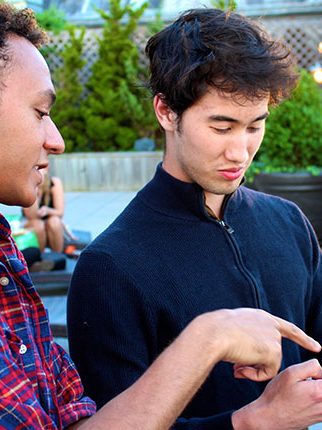Eye Conductor Allows Your Eye Movement and Facial Gestures to Play Music
When Andreas Refsgaard—a Danish interaction designer and creative coder—was a teenager, he served as a caretaker for a young man afflicted with muscular dystrophy. He assisted him with his physical activities, but “helping him express himself creatively was really difficult,” he recently told The Creators Project. “It doesn’t make sense to play an instrument or paint on somebody else’s behalf.”
That problem served as inspiration for Refsgaard’s new musical interface, the Eye Conductor. Still in its prototype stages, it was the final project for his master’s degree at Copenhagen Institute of Interaction Design.
Music therapy is defined by Berklee College of Music as “the applied use of music to measurably improve people’s lives by assisting them in making positive life changes.” With Eye Conductor, Refsgaard is doing just that.

In brief, the Eye Conductor interface has two modes: one, a simple drum sequencer, and two, expressive sounds such as string, piano, or synth-based. Both of these work with eye and mouth movements controlling the sounds, as shown in the video below.
“I want it to be free and open-source. Then maybe I can lay a foundation and people can take it to a whole other level.”
“The Eye Conductor is similar to having a MIDI keyboard,” explains Refsgaard, who currently lives in Amsterdam while he completes an internship. “In itself, it doesn’t have any sounds, but if you connect it to your computer and whatever program you’re using, Ableton or something, then it can control any number of sounds. In that sense, it’s also not an instrument, as such. It’s an interface to control instruments.”
The fascinating progress of the Eye Conductor can be tracked on Refsgaard’s blog, which was started as a way for him to communicate with his advisor, get feedback, and make sense of the chaos.

“Today I got a Facebook message from somebody that I didn’t know—a guy in Dearborn, Michigan,” says Refsgaard as he reads the message out: “‘My name is Vincent, and I have ALS. I saw your Eye Conductor, and I was interested in using it. I was a dance music producer before I got sick. Please let me know if I can use your app.’ Getting messages like that is what makes me think some people are really starting to dream they can go back to playing. I have to package it in such a way that this guy in Michigan can use it. I have to get it out there.”

He continues, “My plan is not to sell this as a product at all. I built it on top of open-source components, at least in the prototype, and I want it to be free and open-source. Then maybe I can lay a foundation, and people can take it to a whole other level.”




